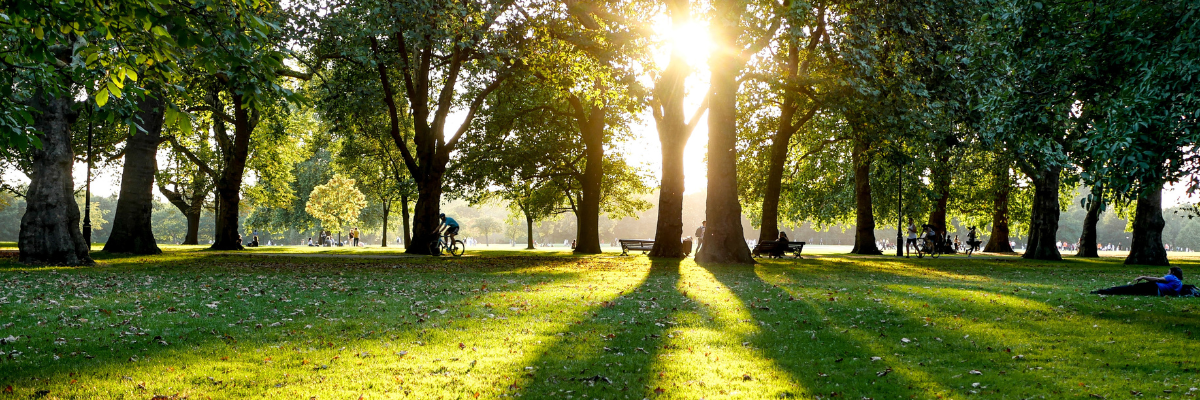FST BLOG
Big Data, Greener Cities
- 26 April 2023
- Environment
- Molly Rains

When I pass through Hyde Park on my way to campus in the morning, my day improves immediately and measurably. The air beyond the iron gates is always fresh, the mist glimmers as it seeps between the trees, and the city dogs look gleeful as they bound across the lawns. To step from the melee of the street into this idyllic scene is a kind of release: a moment of calm that stays with me all day.
I know that the other commuters, dog-walkers, and joggers feel it too. That green spaces can improve our physical and mental wellbeing is well-known and extensively documented. In cities, natural spaces from parks and tree-lined streets to living roofs have positive effects that extend beyond the individual. These include improved air quality, the preservation of biodiversity, tempering of the urban heat island effect, and more.
For these benefits to manifest, however, city planners must ensure that nature is accommodated as cities grow. Local Environmental Records Centres, or LERCs, facilitate this across the United Kingdom by collating environmental data and sharing their expertise with local governments, planners, and developers. London’s LERC is known as Greenspace Information for Greater London, CIC, or GiGL. The team describes their work as “curating and sharing data underpinning our knowledge of London’s natural environment, enabling stakeholders to make informed decisions in policy and practice.” As GiGL Community Officer Victoria Kleanthous told me, “GiGL is a conduit for sharing useful information… we’re here to make sure that [development] considers all residents.”
GiGL’s database is extensive, with local environmental datasets dating from as far back as the 1800s. The holdings cover a wide range of subjects, from the diversity of London’s plants and animals to the accessibility of its open spaces. I was impressed to learn that much of their data is crowdsourced; the majority is collected by motivated locals. “Amateur and volunteer recorders are a really integral and dedicated part of the community,” said Kleanthous. The rest of the data comes, in order of prevalence, from borough offices and environmental consultants.
Alongside these datasets, GiGL analysts provide a range of services, including generating “baseline ecological assessments” of proposed building sites. These reports are crucial to conservation-minded development, including adherence to new biodiversity net gain legislation. This policy, which comes into effect this year, requires developers to boost biodiversity by at least ten percent at every jobsite. This is a significant undertaking, but data can help. “For biodiversity net gain and other similar initiatives to work,” said GiGL Database Officer Tanvi Desai, “we need data to establish a baseline… data to identify endangered species and their habitats, data to target key habitats, and data to monitor ongoing gains and losses.”
The adoption of biodiversity net gain legislation and pushes for urban greening are evidence of the growing trend towards so-called greener cities. However, as the GiGL team is aware, these new policies are not a cure-all. One significant issue is the threat of environmental gentrification, in which the “greening” of a neighbourhood pushes out residents through rent inflation and community disruption. In order to simply tick the box of biodiversity net gain requirements, said Kleanthous, “it might be quite easy for people to just put in new green spaces which don’t consider the local people.” This can result in developments that “look like [they’ve] been airlifted in,” said GiGL CEO Mandy Rudd.
Rather than one-size-fits-all greening, the GiGL team seeks a more equitable form of sustainable development. This change is much needed: as Kleanthous summarised, “people, particularly in urban areas, are excluded from their natural environment – and that’s just not fair.” By integrating multidisciplinary data throughout the planning process, the GiGL team believes that development can do better for both humans and nature. “It makes sense to combine environmental data with economic and social data (particularly in urban areas) to ensure equality of access to ecosystem services and avoid… environmental gentrification,” said Desai. In this way, Rudd agreed, “data help to give local communities and nature a voice.”
The present moment is a crucial one for conservation, here in London and beyond. As biodiversity net gain becomes law, the population continues to grow, and the climate becomes ever more volatile, urban planning is more vital than ever. It’s clear from my conversation with GiGL that data science will continue to play an indispensable role in this field. Additionally, for the benefit of cities, nature, and humans alike, this will ideally be a collaborative effort: “I don’t think that ecological movements work without a strong grassroots element,” Kleanthous told me.
The rest of the GiGL team agreed, hoping that data will continue to be implemented throughout the planning process, development, and beyond. They cited hopes for increased collaboration between developers, scientists and local authorities to allow for the monitoring of London biodiversity and the success of green solutions in the long term. Vitally, they share a vision of a future that’s both sustainable and equitable, in which data can help cities grow greener — and fairer — for all.
For more information on GiGL, their data, and their work, visit them at https://www.gigl.org.uk/
Molly Rains is an MSc Science Communication student at Imperial College London and the current deputy features editor for I, Science (Imperial College science magazine). Reach her at molly.rains22@imperial.ac.uk.
